|
|
|
| My Favourite Planet > English > People > Hermaphroditus |
|
| |
Hermaphroditus
Ancient Greek mythology, religion and art
Hermaphroditus (Greek, Ἑρμαφρόδιτος, Hermaphroditos; also referred to as Ἑρμαφροδίτη, Hermaphrodite) was the child of Hermes and Aphrodite (their Roman equivalents were Mercury and Venus), who had combined male and female characteristics.
In the art of the Hellenistic and Roman periods, the intersexual deity is often depicted in explicitly erotic and even seductive poses, with exposed breasts and male genitals. [1]
|
|
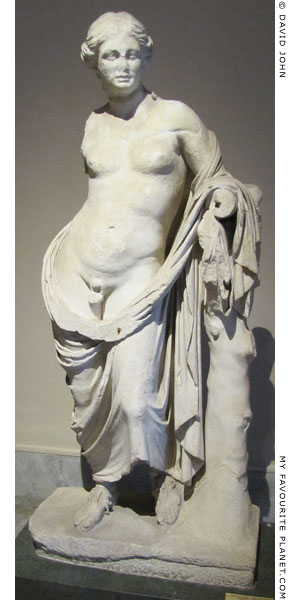
Marble statue of Hermaphroditus
from Pergamon. Hellenistic period,
3rd - 2nd century BC. Height 186.5 cm.
Found in 1879 near the Great Altar
of Zeus on the Pergamon acropolis.
Istanbul Archaeological Museum.
Inv. No. 363 T. Cat. Mendel 624.
See Pergamon gallery 2, page 17. |
|
| |
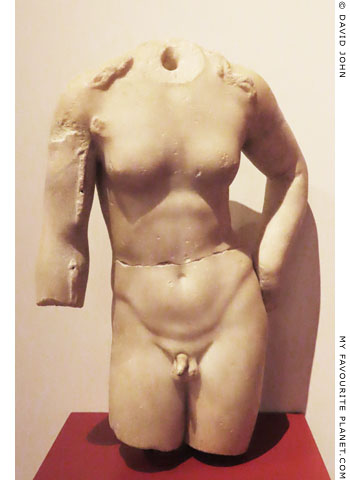
A restored marble statue of Hermaphroditus.
Head, lower right arm and legs now missing.
100-50 BC. Provenance unknown. Perhaps from
Aphrodisia (western Turkey). Height 58.5 cm,
width 38.0 cm, depth 20.0 cm.
Allard Pierson Museum, Amsterdam.
Inv. No. 11.1.
From the collection of G. Hirth who purchased
the sculpture in Venice. It may have been taken
there from a Venetian trading post in the eastern
Mediterranean and to have been part of the
Francesco Morosini collection, auctioned in 1884.
Catalogue No. 28, pages 25-27, plate 12, a-d.
For further information about the Allard Pierson
Museum's catalogue of ancient sculpture, see
the Alexander the Great page. |
|
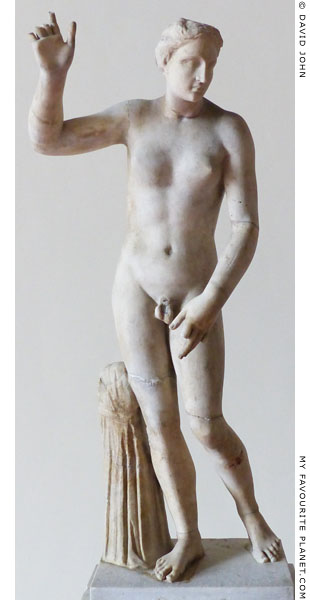
A marble statue of Hermaphroditus
from Pompeii. The figure was restored in
Antiquity, perhaps a number of times, and
has been given pointed ears like a Satyr.
Found in the sanctuary of the Temple of
Apollo, Pompeii, together with a marble
statue of Venus (Aphrodite) [2].
National Archaeological Museum, Naples.
Inv. No. 6352. |
|
| |
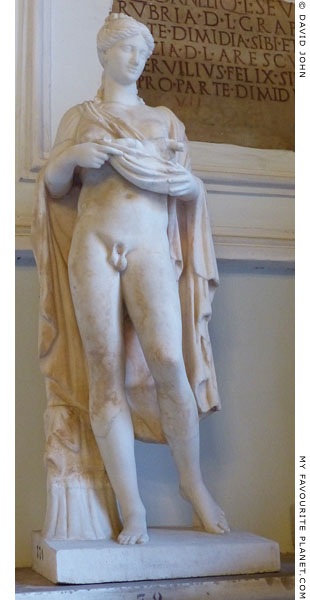
Marble statuette of Hermaphroditus
carrying the winged infant Eros in
the fold of her cloak with both hands.
Roman Imperial period, 1st century AD copy
of a Hellenistic prototype. Perhaps from the
sanctuary of Bacchus or the large imperial
villa at Tor Marancia, southeast of Rome,
during excavations by Luigi Bondi around
1817-1823, financed by Marianna di Savoia,
Duchess of Chablais. Greek marble.
Height 74.5 cm.
Heavily restored: the head and neck, right
shoulder and forearm with hand, and a
third of the fold of the cloak; both legs,
from below the middle of the shins, with
feet, plinth and support; the head, left
arm and legs of the infant. The right arm
of the infant is missing, and the restored
plaster head and penis have been
removed. There are traces of red colour
on the cloak.
Palazzo Nuovo, Capitoline Museums,
Rome. Inv. No. MC370. Acquired in
1823 from the Chablais Collection. |
|
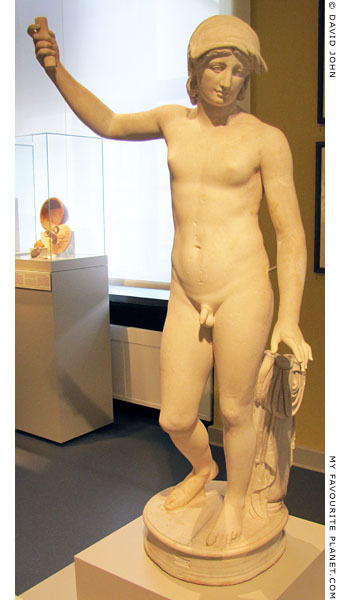
The "Berliner Hermaphroditos" wearing
a mitra (μίτρα), a woman's headscarf.
Circa 120-140 AD. Thasian marble.
Height with base 172.3 cm, base 14 cm.
Altes Museum, Berlin. Inv. No. Sk 193.
The original location of the sculpture is not
known. The Comte de Caylus purchased it for
his collection in 1750 in Paris. It was purchased
for Friedrich Wilhelm III of Prussia in Paris
in 1828 from the sculptor Jean-Pierre Cortot
by the art dealer M. St. Vincent. Karl Friedrich
Schinkel and Christian Daniel Rauch were
also involved in the purchase. |
|
| |
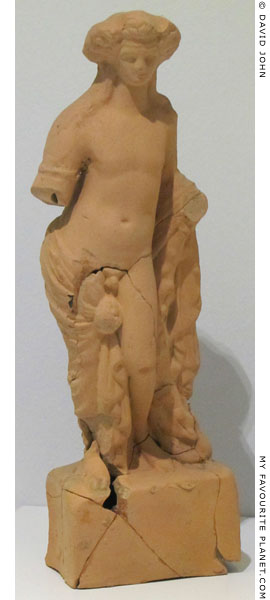
Ceramic figurine of Hermaphroditus.
From the Yortanli Dam Salvage
excavation, near Pergamon.
Bergama Archaeological Museum. |
|

Ceramic figurine of Hermaphroditus.
From the Yortanli Dam Salvage
excavation, near Pergamon.
Bergama Archaeological Museum. |
|
| |

Fragmentary marble statuette
of Hermaphrodite-Attis.
2nd century AD. Found in 1940
in the Sanctuary of Attis, Ostia.
Ostia Archaeological Museum.
Inv. No. SBAO 169. |
|
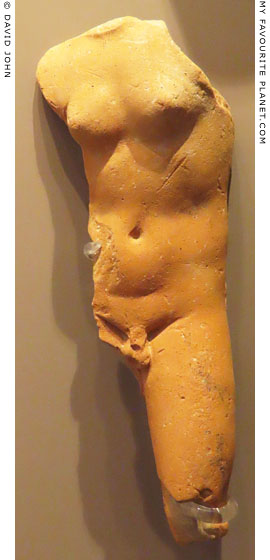
Fragment of a ceramic statuette
of Hermaphrodite.
2nd century AD. Found in the
sanctuary of Athena in the city
of Kos, Dodecanese.
Kos Archaeological Museum. |
|
| |

Part of a marble statue
of Hermaphroditus.
From Rome. 2nd century AD.
From the Arundel Collection, which originally
included two statues of hermaphrodites:
one excavated in Rome by Thomas Howard,
and the other given to his wife by Alathea
by the Papal agent George Conn.
Ashmolean Museum, Oxford.
Inv. No. Michaelis 34. |
|
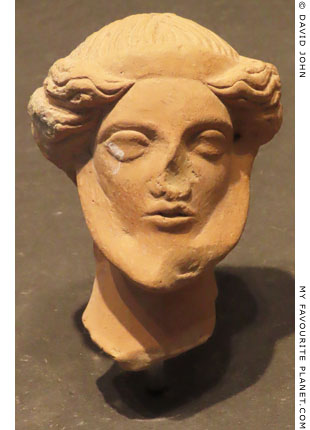
Head of a terracotta Hermaphroditus figurine.
Hellenistic period. Found in a ceramic
workshop of the ancient city of Korkyra
(Κόρκυρα), Corfu.
Corfu Archaeological Museum. |
|
| |
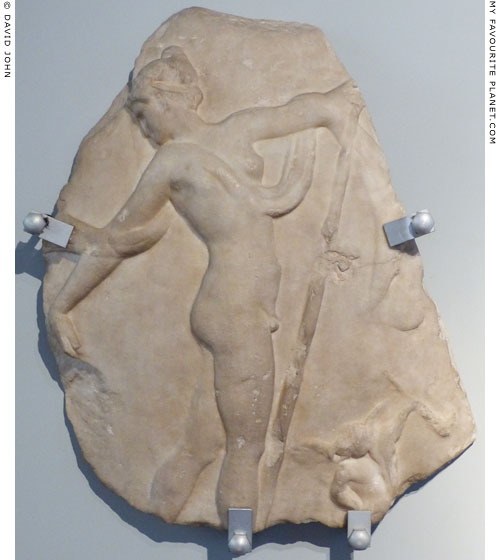
A fragment of a neo-Attic marble krater (wine bowl) with a
relief of Hermaphroditus dancing with a winged infant Eros.
Reign of Augustus, 27 BC - 14 AD. Pentelic Marble.
Height 57.5 cm, width 46 cm.
Barracco Museum, Rome. Inv. No. MB 170.
From the Steinhäuser Collection.
|
The naked, youthful figure of Hermaphroditus dances to the right, both arms raised, her upper torso bent back, and her head facing backwards to the left. A cloak (perhaps an animal skin) is draped over her right shoulder and around both arms at the elbow. The left end (to the viewer) swings upwards with her movement. The ecstatic dancing is similar to that of Maeands, female followers of Dionysus, and the staff she carries in her left hand may be a thyrsos (see Dionysus), although its top is now missing.
At the bottom right of the fragment of part of a small figure of a winged infant Eros, who also appears to be dancing, and holds what looks like an inverted torch in his raised left hand.
The date and place where it was found are unknown, perhaps the on Esquiline Hill, between Porta Maggiore and S. Croce in Geruslamme, Rome. It was in the possession of the sculptor Steinhäuser before it was acquired Senator Barracco for his collection in 1893. |
|
|
| |
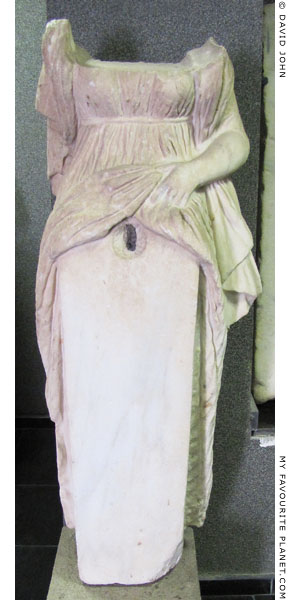
Fragment of a marble herm of
Hermaphroditus raising his/her
garment to reveal male genitals.
The term used by modern scholars to
describe this skirt-lifting pose and a figure
so depicted is anasyrma (Ancient Greek,
ἀνάσυρμα; from ἀνά, ana, up, against,
back, and σύρμα, syrma, a dragging
motion; plural anasyrmata, ἀνασύρματα)
or anasyrmos (ἀνασυρμός, the masculine
version). Apart from obvious connections
with the effect of surprise and erotic
humour, as well as the apotropaic
(warding off evil) function of the phallus,
particularly in Roman religion, the specific
significance of this gesture in the rituals
around the worship of Hermaphroditus
remains opaque to the modern mind.
Hellenistic period. Found in 1899 in the
olive grove of Ilias Deliapostolis, in the
Kestel river valley, at the foot of the Pergamon acropolis. Height 124 cm.
Bergama Archaeological Museum. |
|
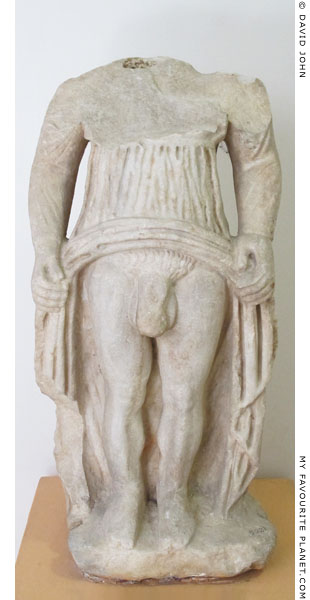
Fragment of a marble statuette of
Hermaphroditus of a common type,
showing the deity raising his/her
garment to reveal male genitals.
Roman period, 2nd century AD.
Height 67 cm, width 32 cm, depth 22 cm.
Izmir Museum of History and Art.
Inv. No. 5921.
The torso of a similar marble statuette,
the so-called "Priapos Statuette", allegedly
from Ephesus, was purchased in Smyrna
(Izmir) in 1877 by Carl Humann, and is now
in the Antikensammlung of the Berlin State
Museums (SMB), Inv. No. Sk 246. A complete
and more refined statue of the subject, from
the 3rd century AD, is in the Louvre. |
|
| |
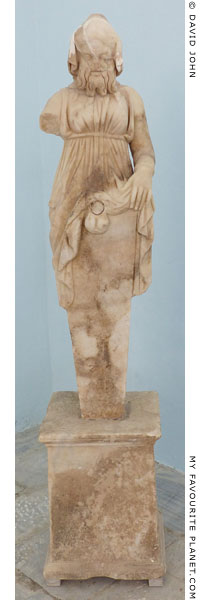 |
|
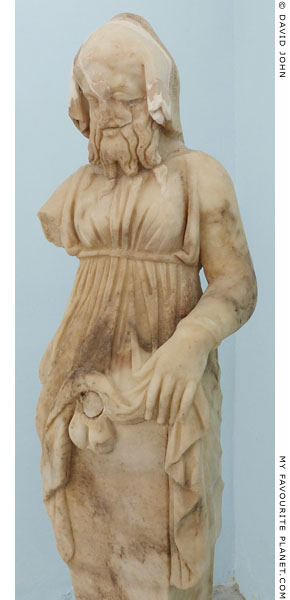 |
Marble herm of Hermaphroditus-Priapus
(also referred to as Priapus-Hermaphrodite).
Roman period, late 2nd - early 1st 1st century BC.
From the Theatre Quarter, Delos.
Delos Archaeological Museum, Greece. Inv. No. A 350. |
|
| |
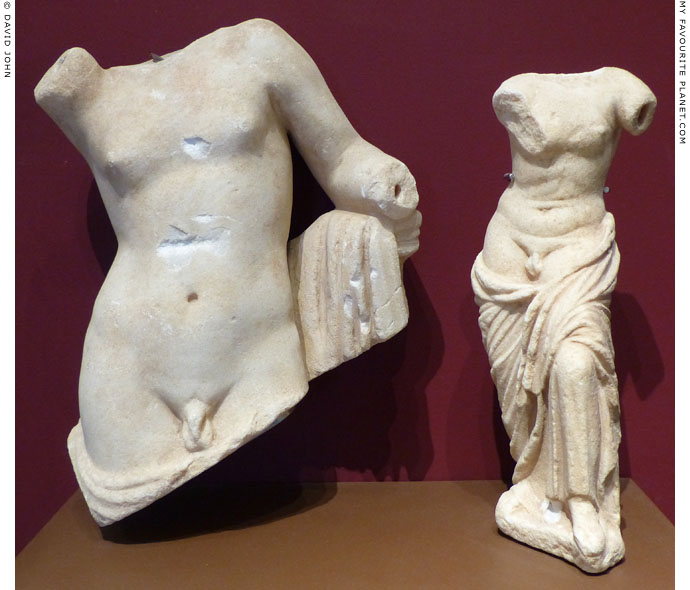
Left: A fragmentary marble statuette of Hermaphroditus from Thebes, Boeotia, central Greece.
Right: A fragmentary marble statuette of Hermaphroditus from Chaeronea, Boeotia, central Greece.
Roman Imperial period.
Thebes Archaeological Museum. |
| |
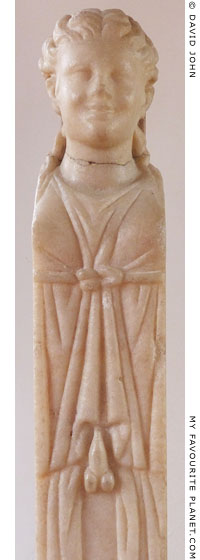
Detail of a trapezophoron
(table support) in the
form of Hermaphroditus.
1st century BC - 1st century AD.
Parian marble. Height 70 cm.
Barracco Museum, Rome.
Inv. No. MB 183. |
|

Fragmentary marble statuette of Hermaphroditus.
Roman Imperial period. Provenance unknown.
Thessaloniki Archaeological Museum.
Inv. No. MΘ 1119. |
|
| |
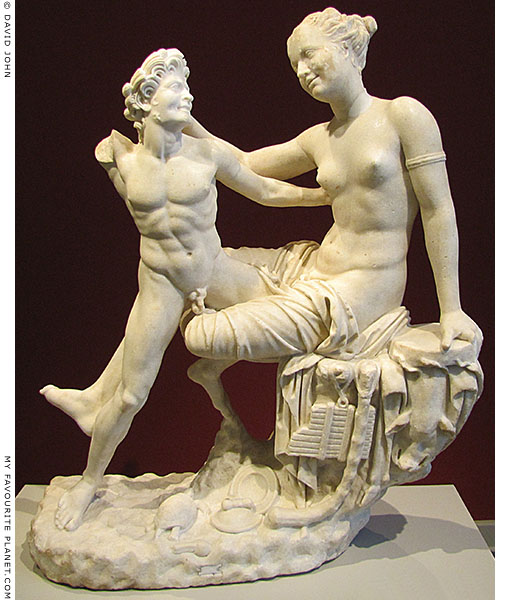
Statue of Hermaphroditus and a satyr at erotic play, Berlin-Torlonia type.
Parian marble. 2nd century AD Roman copy of a Hellenistic original,
probably of the 2nd century BC. Height of Hermaphroditus 122.6 cm.
Altes Museum, Berlin. Inv. No. 195.
Purchased from an art dealer in Rome in 1826 by Karl Josias Freiherr von Bunsen.
Perhaps from the Aldobrandini Collection.
|
Statue groups depicting this subject are known from a number of examples and fragments in other museums, for example in Cherchell and Algiers, Algeria, Antakya, Turkey, Rome and Dresden (see photo below). Such representations of erotic entanglements are often referred to as symplegmata (plural of σύμπλεγμα, symplegma, braided, or entwined), meaning figures grappling or wrestling.
This group has been extensively restored. The satyr's head is modern, Hermaphroditus' head is ancient but belongs to another statue. The objects below the couple are Dionysian-bucolic attributes, including musical instruments (tamborine and cymbals) and a tortoise, as well as the syrinx (Pan pipes) and lagobolon (also associated with Pan). |
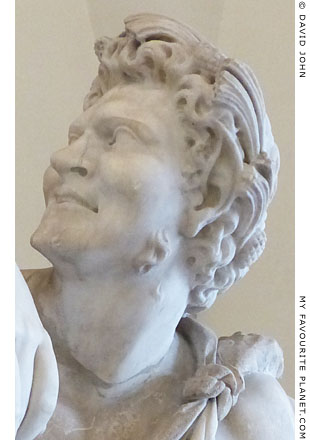
The type of head of a satyr used as a
model for the restoration of the statue.
This head is from a statue group with
Dionysus, a young satyr and a panther,
in the Palazzo Altemps, National Museum
of Rome. Inv. No. 8606. |
| |
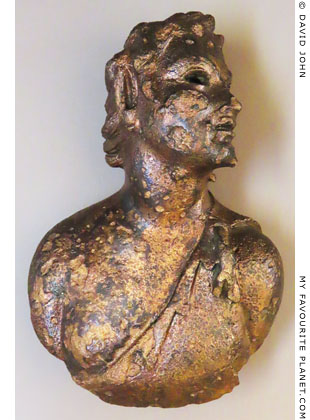
Small bronze bust of a Satyr, made in Kos.
Roman Imperial period, 1st - 3rd century AD.
Found in a storeroom in the ancient agora
of Kos, Dodecanese.
Kos Archaeological Museum. |
| |
| |
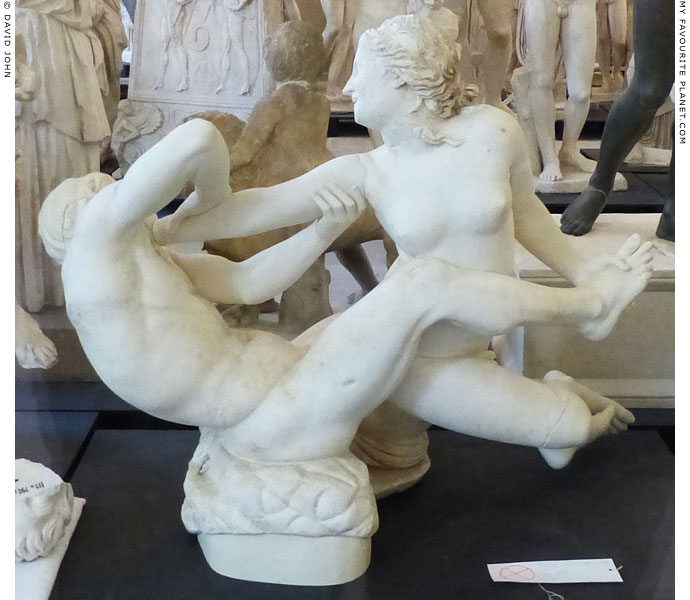
A restored marble statue group, known as the "Dresden symplegma", of Hermaphroditus
and a satyr at erotic play. The composition of the group is lively and complex, particularly the
intertwining of the couple's limbs and the almost impossible position of Hermaphroditus' right leg.
2nd half of the 1st century AD. Roman period copy of a Hellenistic
original, probably of the late 2nd century BC. From Tivoli, near Rome.
Height 90.5 cm, width 104 cm, depth 64 cm.
Skulpturensammlung, Albertinum, Dresden. Inv. No. Hm 155.
From the Albani Collection.
Currently (2017) in a crowded temporary exhibition of ancient
sculptures, behind a glass wall in the entrance hall, following
damage to the building caused by flooding in 2002. |
| |
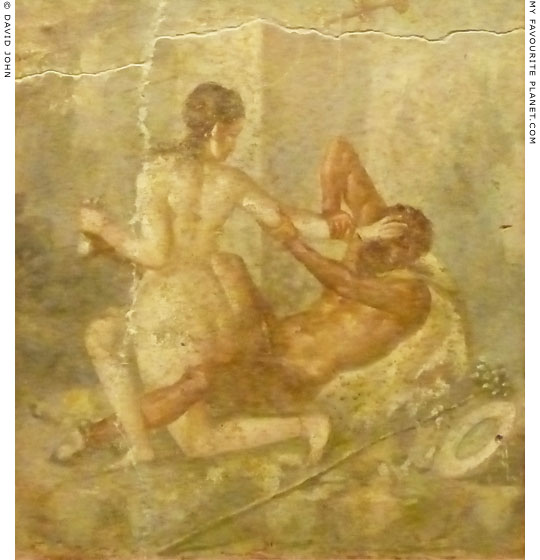
Fresco of Hermaphroditus and a satyr at erotic play. The positions and poses
of the two figures are identical with the Dresden sculpture group above.
Wall painting from Pompeii. 1-50 AD.
National Archaeological Museum, Naples. Inv. No. 110878. Secret Cabinet. |
| |
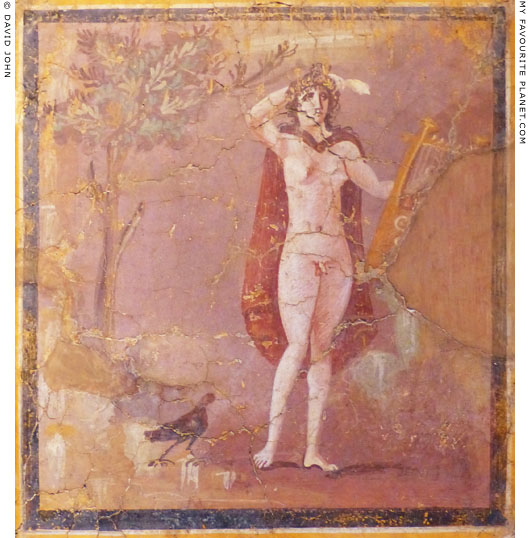
A fragmentary fresco panel depicting Hermaphroditus from
Capua, Campania, Italy. Second half of the 3rd century AD.
Hermaphroditus is shown naked apart from a red cloak and a golden
laurel wreath. In the manner of depictions of Apollo and Dionysus,
he/she rests his right hand on his head and carries a kithara in the left.
Barracco Museum, Rome. Inv. No. MB 214. |
| |

Fresco painting of Hermaphroditus.
From Herculaneum. 1-50 AD.
National Archaeological Museum, Naples. Inv. No. 9224. Secret Cabinet. |
| |
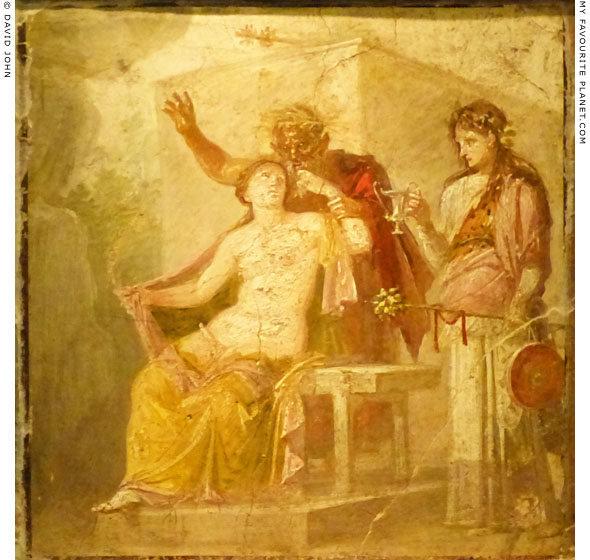
Fresco with Hermaphroditus, an aged satyr (Silenus) and a maenad.
Discovered in 1866 in the centre of the east wall of the tablinum
(Room h) of the Casa di M. Epidus Sabinus, Pompeii (Casa IX, 1, 22.29).
50-79 AD (according to K. Schefold after 63 BC). 4th Pompeiian style.
Height 50 cm, length 50 cm.
National Archaeological Museum, Naples. Inv. No. 27875. Secret Cabinet.
|
Hermaphroditus sits on a bench with an exposed erect penis, his garment lowered and resting on his thighs. The satyr with a wreath and dressed in red, stands behind him and grasps the god's raised left forearm with his left hand and raises his own right hand. To the right stands a maenad, wearing a wreath and a doeskin nebris, and holding in her right hand a kantharos (drinking cup), and in her left hand a thyrsos (an attribute of Dionysus) and a tamborine.
The tall construction behind the figures appears to be an altar, and the greenery and rocks to the left suggest a cave sanctuary in a rural setting.
For further information about satyrs, maenads, the thyrsos and nebris, see Dionysus. |
|
|
| |
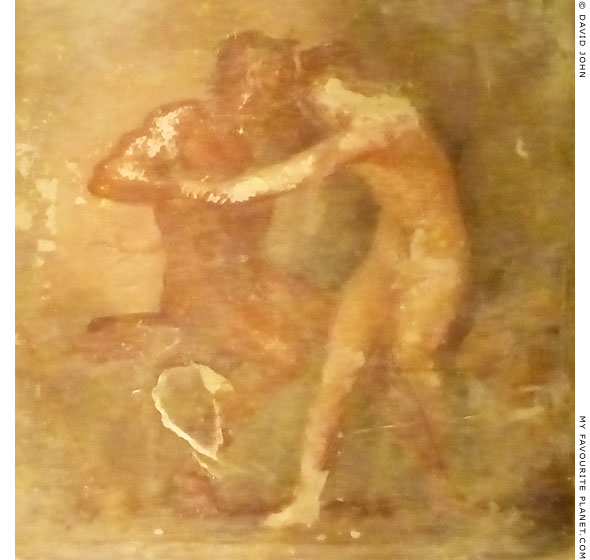
A fresco with Hermaphroditus and a satyr.
From Herculaneum. 4th style. 50-70 AD. Height 36 cm, length 39 cm.
National Archaeological Museum, Naples. Inv. No. 27701. Secret Cabinet. |
| |
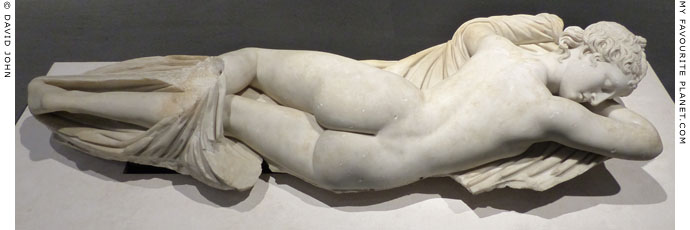
Marble statue of sleeping Hermaphroditus.
Anatolian marble. Circa mid 2nd century. A copy of a 2nd century BC
bronze original of the Asia Minor school. Found in 1879 in the ruins
of an ancient house near the Teatro dell'Opera, Rome. Length 148 cm.
Palazzo Massimo alle Terme, National Museum of Rome. Inv. No. 1087.
|
The nude figure, partly covered by a cloth, perhaps a himation (cloak), is described as "caught changing position while asleep, thus revealing a dual nature with male and female sexual characteristics". It is thought that such statues were positioned in a room or space so that the viewer entering and seeing it for the first time from behind would assume the figure was female. Moving around to the other side the viewer would then be surprised, shocked, delighted, amused or titillated to see that it had not only breasts but also male genitals.
Apart from the erotic and comic aspects of such sculptures, little is known about the more serious or spiritual intentions of the makers or commissioners of such works, or when or where the first example was made. There appears to be no mention of sleeping Hermaphroditus in ancient literature. The concept may have evolved from depictions of other sleeping mythological figures such as Maenads and the sleeping Ariadne, which became more common and overtly erotic during the Hellenistic and Roman periods. [3]
The Sleeping Maenad statue in Athens (see below) is almost identical except that the figure lacks the male genitals. Probably the most famous marble copy, known as the Borghese Hermaphrodite, is in the Louvre, Inv. No. MA 231, and another copy is in the Uffizi, Florence, Inv. No. 343 (from the Ludovisi Collection). |
|
|
| |

The sleeping Hermaphroditus statue in the Palazzo Massimo alle Terme from the front. |
| |

Detail of the sleeping Hermaphroditus statue in the Palazzo Massimo alle Terme. |
| |

Marble statue of a sleeping maenad, of the type known as the sleeping Hermaphrodite
or reclining Hermaphrodite, lying on a panther skin spread on a rocky surface.
Pentelic Marble. First half of the 2nd century AD, during the reign of Emperor Hadrian
(117-138 AD). Found in 1880, south of the Athenian Acropolis. Length 136 cm.
Thought to be the work of an Attic workshop and to have decorated a luxury residence.
While the sleeping Hermaphroditus in the Palazzo Massimo is exhibited unprotected,
this statue is confined by a low glass case, making it more difficult to view.
National Archaeological Museum, Athens. Inv. No. 261. |
| |
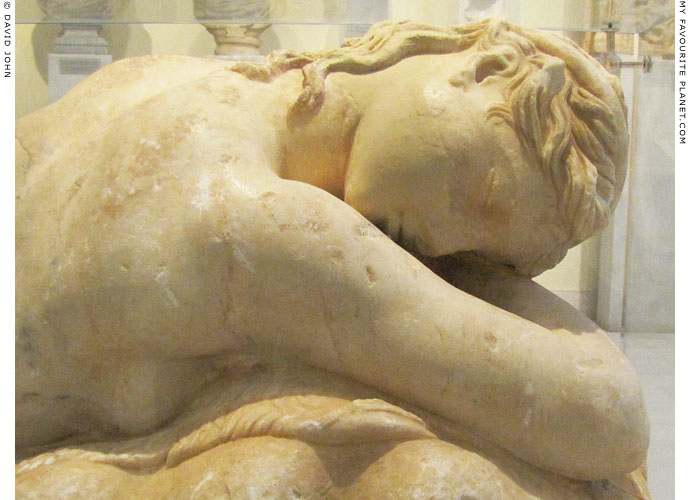
Detail of the sleeping maenad statue in Athens. |
| |
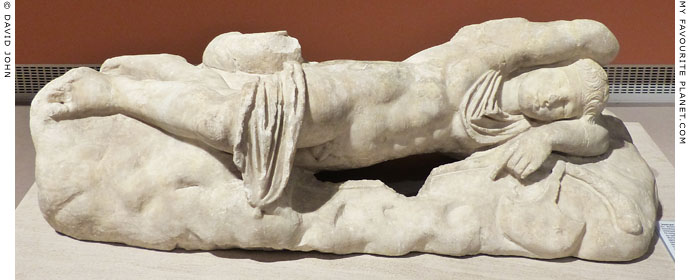
Marble statue of a young sleeping hunter, similar to the sleeping Hermaphrodite type.
Part of the decoration of a fountain in a Roman villa in Patras (Πάτραι).
Roman period. Thought to be a copy of a Hellenistic original.
Patras Archaeological Museum.
|
| As in the sleeping Hermaphrodite type statues, the attractive young man lies naked on a rocky surface. He sleeps on his left side, on top his himation (cloak) which also covers part of his chest and right thigh. A petasos (broad-brimmed hat, see Hermes) rests on his right shoulder blade. His head rests on his left arm, and in his left hand he holds his lagobolon (hunting stick, see Pan), from which hangs a small pouch, reminiscent of the kibisis (κίβισις) used by Perseus to hold the Gorgon's head (see Medusa). His right arm is raised to cover his head; the right forearm and hand are missing. Behind him sits his dog whose head is also missing. |
|
|
| |
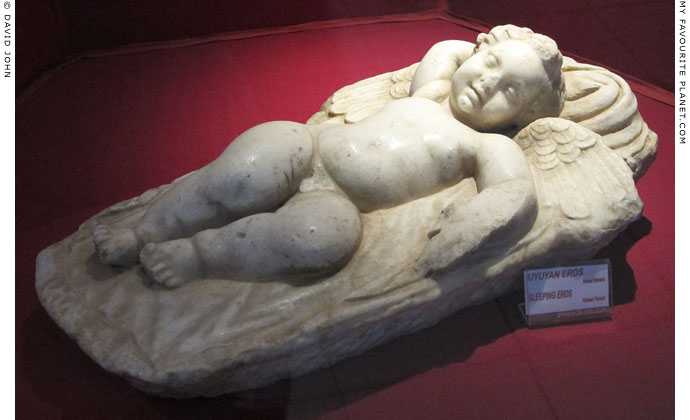
Marble statue of sleeping infant Eros, son of Aphrodite and half-brother of Hermaphroditus.
Roman period. Found in Ephesus in 1928.
Height 19.5 cm, length 62.5 cm, width 42 cm.
Department of Sculpture, Izmir Museum of History and Art. Inv. No. 612. |
| |
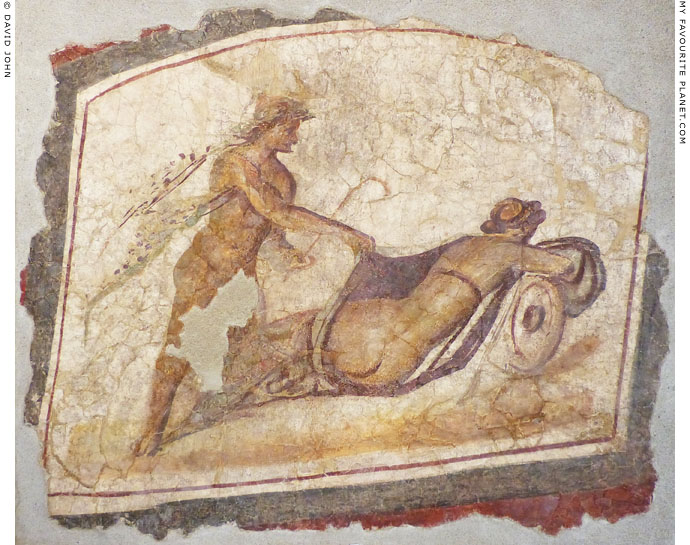
A Roman fresco in Rome labelled "Fresco with Pan and Maenad".
Painted plaster, 193-211 AD.
Antiquarium Communale, Capitoline Museums, Rome.
|
One of several frescos, depicting domestic, rustic and mildly erotic scenes, found in private houses near the Via Nationale in Rome. In this painting a nude male figure wearing a garlanded helmet uncovers a sleeping woman. He does not appear to have horns, and the legs and feet are so crudely drawn that it is difficult to tell whether they are human or goat. The only other indication that he may be Pan is the lagobolon (a crook and hunting stick for throwing at hares) he carries.
The scene is reminiscent of depictions of Dionysus, with Pan and other members of his thiasos, discovering the sleeping Ariadne on Naxos (see Selçuk gallery 2, page 2). On the other hand, the sleeping figure may be Hermaphroditus. |
|
|
| |

Fresco with Hermaphroditus and Pan from Pompeii.
4th style. Around 62-70 AD. Discovered in 1828 above the door to peristyle
on the south wall of atrium 37 of the Casa dei Dioscuri, Pompeii (Casa VI, 9, 6).
Re-assembled from several fragments. Height 75 cm, length 125 cm.
National Archaeological Museum, Naples. Inv. No. 27700. Secret Cabinet.
|
Most of the frescos, mosaics and other decorations from Pompeii, Herculaneum and nearby sites are difficult to date accurately. However, in this case archaeologists believe that the house had been repaired, completely replastered and repainted following an earthquake before the fatal eruption of Vesuvius in 79 AD.
Although several Roman artworks show Hermaphroditus defending herself from erotic advances of satyrs, here the tables have been turned. It appears that the goat-footed god Pan, shown in other scenes sexually drawn to Aphrodite and even goats (see the Pan page), is here trying to escape from Hermaphroditus' grasp. The signal he sends with his raised right hand says it all. |
|
|
| |
| Hermaphroditus |
Notes, references and links |
 |
|
1. Hermaphroditus
See Victor Ljunggren Szepessy's thesis discussing the statue of Hermaphroditus from Pergamon:
Victor Ljunggren Szepessy, The Marriage Maker: The Pergamon Hermaphrodite as the god Hermaphroditos, divine ideal and erotic object. Master of Arts thesis in Art History. University of Oslo, 2014.
2. Statues of Hermaphroditus and Venus from the Temple of Apollo, Pompeii
The marble statue of Venus. National Archaeological Museum, Naples. Inv. No. 6294.
The statues were found at the south side of the sanctuary courtyard of the Temple of Apollo, and they originally stood on pedestals found at the top of the steps of the portico surrounding the sanctuary, which is still standing. They are thought to "belong to the pre-Roman period", i.e. Greek. The pointed ears of the Hermaphroditus, led archaeologists to believe that it was connected with the cult of Bacchus (Dionysus), and catalogues of the Naples museum described the statue as "Bacchus Hermaphroditus".
See: Domenico Monaco, Complete hand book to the National Museum in Naples. English edition by Eustace Neville Rolfe (1845-1908). 4th Edition, No. 6352, page 58. William Clowes and Sons, London, 1886. At the Internet Archive.
"Other divinities besides Apollo were honored in this sanctuary, which in the earlier time was evidently the most important in the city; statues and altars for their worship were placed in the court. The pedestals of the statues still remain where they were originally placed, on the step in front of the stylobate of the colonnade; the statues themselves, with one exception, have been taken to Naples. There were in all six of them, grouped in three related pairs. In front of the third column at the left of the entrance, stood Venus, at the right was a hermaphrodite – both marble figures of about one half life size. They belong to the pre-Roman period and were originally of good workmanship, but even in antiquity they had been repeatedly restored and worked over. As a work of art, the hermaphrodite is the more important.
An altar stands before the statue of Venus. In pre-Roman times this may have been the only shrine in the city at which worship was offered to Herentas; for by that name the goddess of love was known in the native speech. Venus as goddess of the Roman colony, was represented in an altogether different guise, and must have had a special place of worship elsewhere.
Though the statues of Venus and of the hermaphrodite here form a pair, both artistically and in respect to arrangement, the latter belongs not to the cycle of Venus but to that of Bacchus; and in order to make this the more evident, the ears of a satyr were given to the figure. We may, perhaps, infer that the god of wine also was worshipped in this sanctuary."
August Mau (1840-1909), Pompeji in Leben und Kunst. English translation by Francis W. Kelsey, Pompeii: its life and art, page 87. Macmillan, London and New York, 1899. At the Internet Archive.
3. Sleep in Greek and Roman art
For a discussion of sleep and sleepers depicted in Greek and Roman art see:
Sheila McNally, Ariadne and others: Images of sleep in Greek and early Roman art. Classical Antiquity, Vol. 4, No. 2 (October 1985), pages 152-192. University of California Press. At jstor. |
|
|
| |
Photos on this page were taken during
visits to the following museums:
Germany
Berlin, Altes Museum
Dresden, Albertinum, Skulpturensammlung
Greece
Athens, National Archaeological Museum
Corfu Archaeological Museum
Delos Archaeological Museum
Kos Archaeological Museum
Patras Archaeological Museum
Thebes Archaeological Museum
Thessaloniki Archaeological Museum
Italy
Naples, National Archaeological Museum
Ostia Archaeological Museum
Rome, Barracco Museum
Rome, Capitoline Museums, Palazzo Nuovo
Rome, National Museum of Rome, Palazzo Altemps
Rome, National Museum of Rome, Palazzo Massimo alle Terme
Netherlands
Amsterdam, Allard Pierson Museum
Turkey
Bergama Archaeological Museum
Istanbul Archaeological Museum
Izmir Museum of History and Art
United Kingdom
Oxford, Ashmolean Museum
Many thanks to the staff of these museums. |
|
| Photos and articles © David John, except where otherwise specified. |
 |
Visit the My Favourite Planet Group on Facebook.
Join the group, write a message or comment,
post photos and videos, start a discussion... |
|
|
| |
|
|
| |
| |
 |
| |
 |
| |
 |
| |
 |
| |
 |
| |
 |
| |
George Alvanos
rooms in
Kavala's historic Panagia District
Anthemiou 35,
Kavala, Greece
kavalarooms.gr
|
| |
Olive Garden Restaurant
Kastellorizo,
Greece
+30 22460 49 109
kastellorizo.de
|
| |
Papoutsis
Travel Agency
Kastellorizo,
Greece
+30 22460 49 286
greeklodgings.gr
|
| |
|